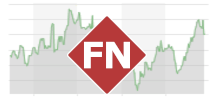
SASKATOON, SK / ACCESSWIRE / February 20, 2024 / Abasca Resources Inc. ("Abasca" or the "Company") (TSX V:ABA) is pleased to provide exploration updates on the 100%-owned, 23,977-hectare Key Lake South Uranium Project ("KLS") in Northern Saskatchewan and to announce its exploration plans for 2024. The Company continues to focus on advancing its exploration at KLS towards a uranium discovery and is planning a 5,000 metres drill program to test prospective target areas and trends. A re-sampling program to evaluate graphite potential in what is now referred to as the "Loki Zone" is planned after recent assay and QEMSCAN analyses of samples in the Campbell target area returned significant results from the 2016 drill program.
Drill Program
In 2023, the Company completed two drill programs totalling 10,135 m. The programs were designed as initial follow-up to historic shallow drilling conducted in 1978 and 1979 that intersected graphitic fault zones and local clay alteration. In addition to intersecting anomalous uranium mineralization at the Mustang target area (see news release on May 24, 2023), the 2023 drilling confirmed prospective graphitic structures and local oxidation, bleaching, silicification, and clay alteration.
The 2024 drill program is planned to continue the methodical testing of prospective uranium targets at KLS, including parts of the Mustang-Seager Lake conductor corridor along strike of the Key Lake uranium deposits, as well as the Campbell and Zimmer target areas (Figure 1).
- The Mustang-Seager Lake trend is part of a regional conductive corridor that extends along-strike toward the Key Lake uranium deposits. The KLS Uranium Project includes 10 km of this corridor that comprises multiple stacked graphitic fault zones and includes anomalous uranium up to 1,260 ppm U that was intersected at the Mustang target area in 2023. The 2024 drilling will focus on testing structural breaks and bends in the central and northern segments of this largely untested corridor (Figure 2).
- The Zimmer target area is located in the central part of the Project area and the 2024 drilling plans to follow-up on previously intersected clay alteration.
- The western section of the Campbell target area was previously drilled in 2016 and intersected anomalous uranium up to 2,160 ppm U in a sample from drillhole KS-CC16-13. In addition, an intensely graphitic fault zone was intersected over 40 m of core length and has a known 2 km strike-length. The 2024 drilling at Campbell is planned to follow-up on the anomalous uranium intersection, as well as test the extents of the main fault zone to evaluate its economic potential for graphite in the Loki Zone.
Brian McEwan, VP Exploration, stated: "The intersection of re-activated graphitic fault zones, hydrothermal alteration, and anomalous radioactivity in the 2023 drilling keep us optimistic that we are on the right track. We have only tested a narrow portion of the prospective corridors at KLS, and we are confident in our systematic approach to determine where we should focus our efforts in future exploration programs."
Loki Zone Graphite
In addition to uranium, Natural Resources Canada also lists graphite as a critical mineral. Graphite is one of six critical minerals considered essential for priority supply chains for modern clean technologies such as batteries for Electric Vehicles (EVs). Recent review of the drill cores from a drilling program conducted in 2016 at the Campbell target area (Figure 3) concluded that further evaluation of its graphite potential is warranted. The 2016 drilling intersected a moderately-dipping strongly graphitic fault zone over a 2 km strike-length. Intersections of the graphitic fault were within the first 200 m of each drillhole and up to 40 m down hole (Figures 4 and 5). The extents of the fault zone are currently open along-strike and down-dip.
Samples from the 2016 drill program, stored at SRC Geoanalytical Laboratories in Saskatoon, were selected for graphite content as an initial test to determine further work (Table 1). Several samples were also selected for flake size and morphology analysis by QEMSCAN. The samples were originally collected to evaluate pathfinder elements as part of uranium exploration and therefore only representative samples were collected and the entire graphitic zone and its surrounding area was not sampled.
Loki Flake Graphite Highlights
- Strongly graphitic fault zone with intersections up to 40 m down hole and a 2 km strike-length.
- Shallow mineralization - intersections within first 200 m of drilling and open down-dip.
- Multiple intersections with total graphite greater than 10%, including up to 22.2% in a 50 cm sample in hole KS-CC16-12.
- Median diameter passing percentage for 10 samples selected for QEMSCAN: 147 µm, including a sample up to 214 µm.
Resampling of the graphite mineralization in 2016 drillcore is planned to be completed during the summer in conjunction with the 2024 drill program.
"Abasca's team remains focused on locating potential uranium deposits at KLS, and we will continue to explore all identified uranium target areas on the KLS Uranium Project. Meanwhile, we are pleased with the preliminary grade and mineralogic results of the flake graphite at the Loki Zone and look forward to contributing to Saskatchewan's critical minerals strategy on diversified target minerals" stated Dawn Zhou, President and CEO.
Collected samples in 2016 were originally sent to SRC Geoanalytical Laboratories in Saskatoon, Saskatchewan, an independent laboratory accredited under ISO/IEC 17025:2017 for preparation and ICP-MS multi-element analysis and Boron by fusion. The pulps from the samples have been stored at SRC Geoanalytical Laboratories and were analysed for graphite content and total sulphur by LECO. Samples were originally collected in 2016 as part of a uranium exploration program in accordance with industry-standard quality assurance / quality control practices and included the insertion of blanks, standard reference materials, and repeats into the sample stream at regular intervals; however, no graphite reference materials were used.
For more information and an overview of the Key Lake South Uranium Project, please visit the Company's website at https://www.abasca.ca.
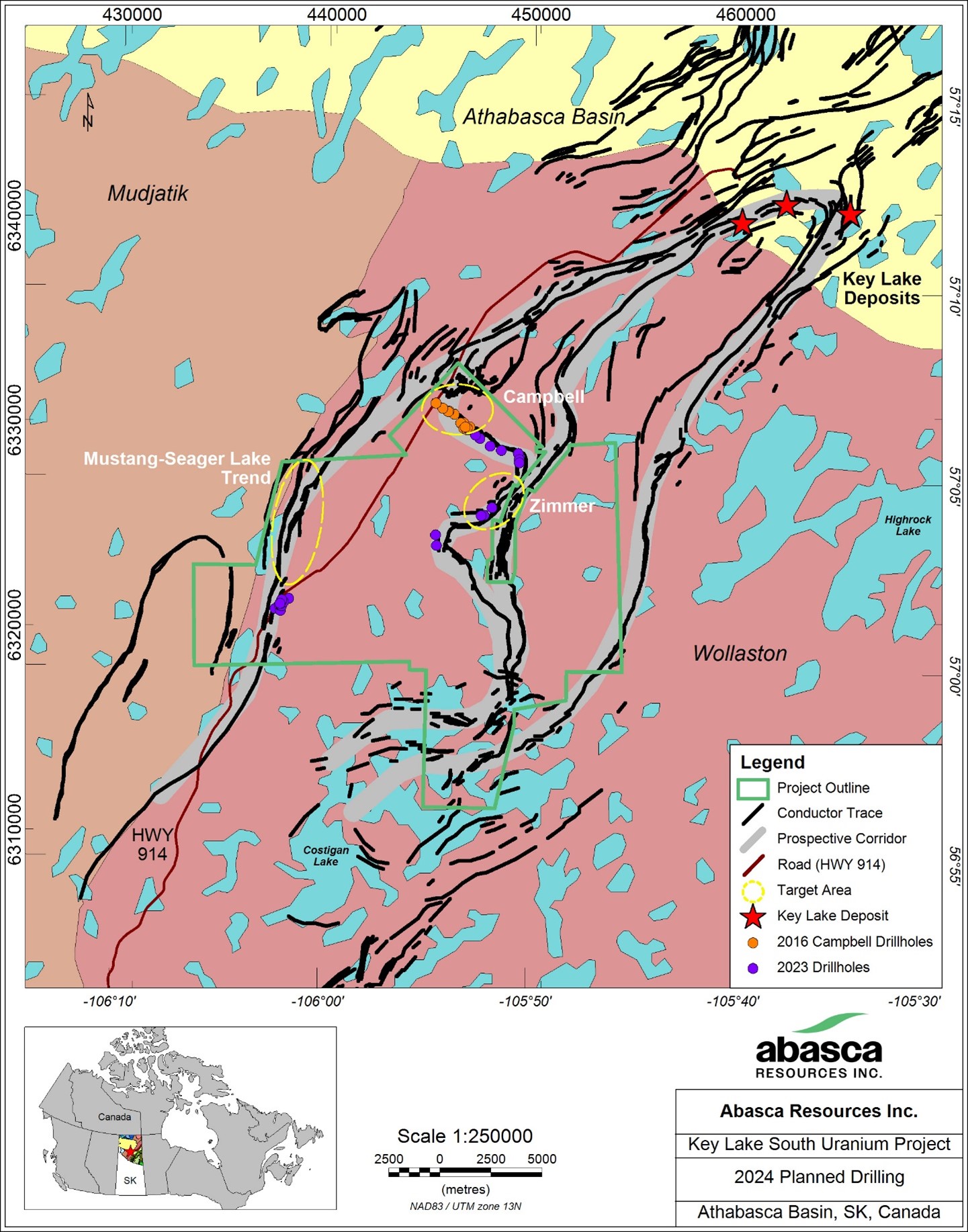
Figure 1: Map of the Key Lake South Uranium Project area showing the planned target drill areas for the 2024.
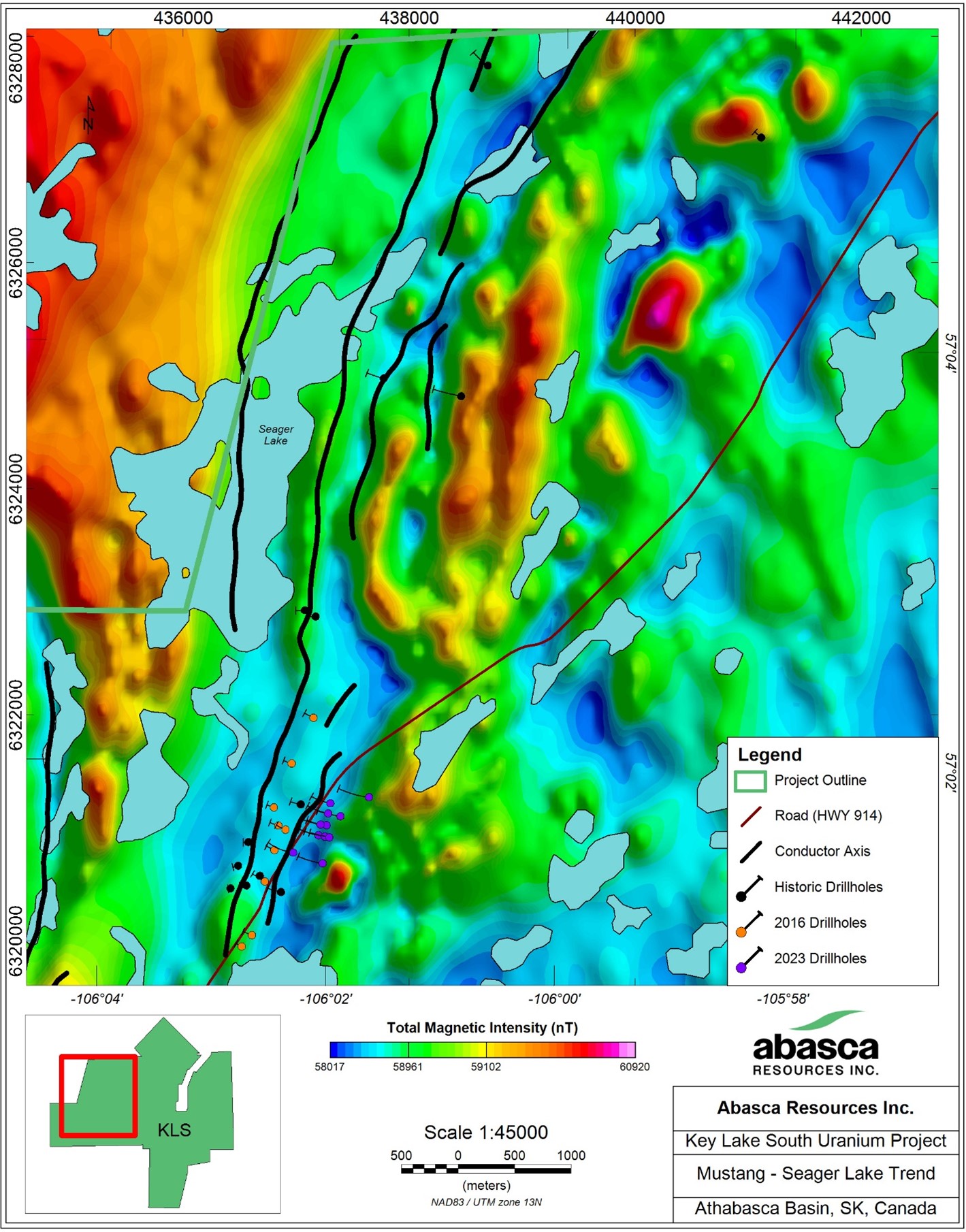
Figure 2: Map of the central and northern Mustang - Seager Lake conductor trend on the KLS Uranium Project showing previous drillholes over the total magnetic intensity.
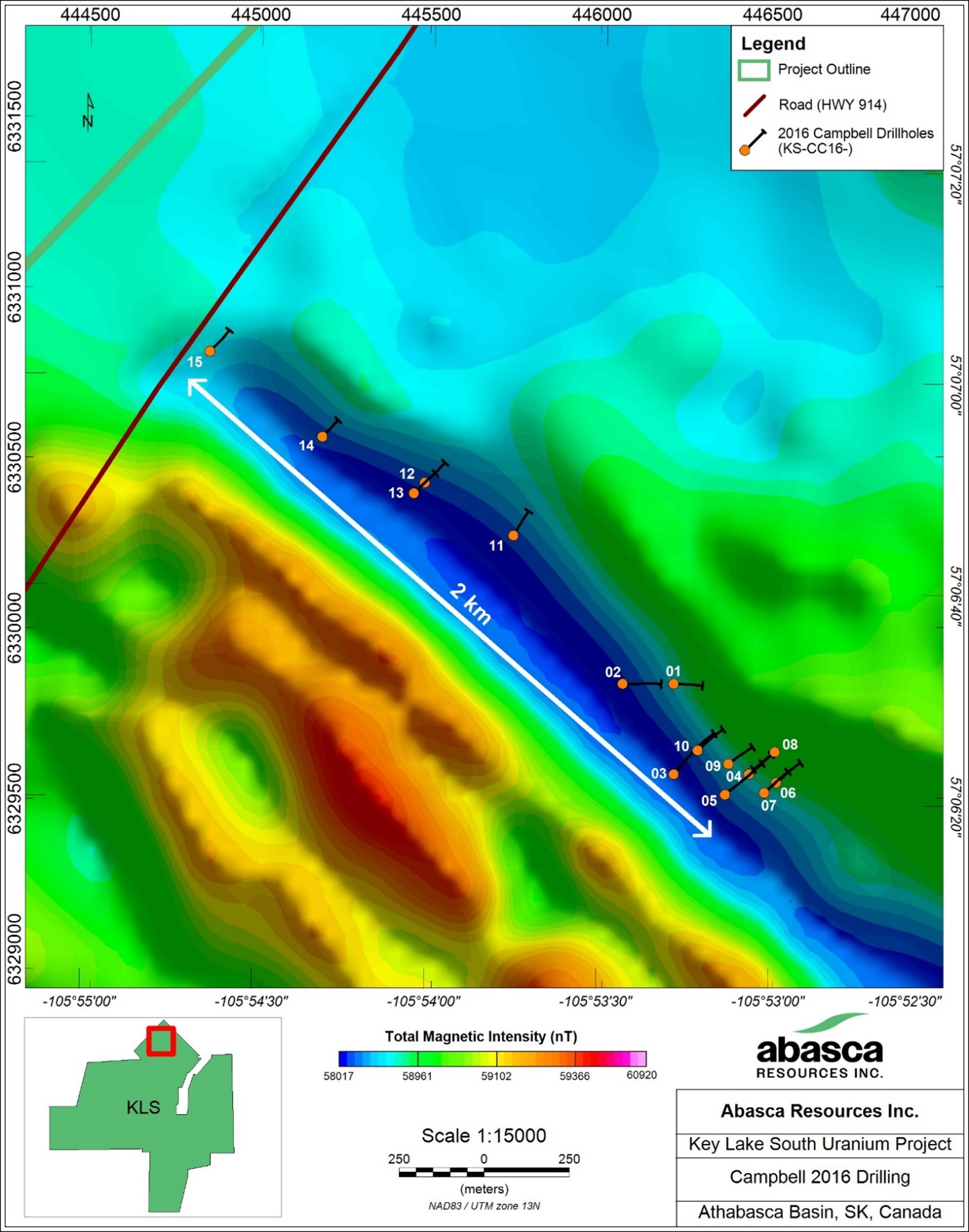
Figure 3: Map of the Campbell target area showing the 2016 drillhole locations over the total magnetic intensity. Note the blue linear feature trending northwest-southeast is delineates the fault zone.
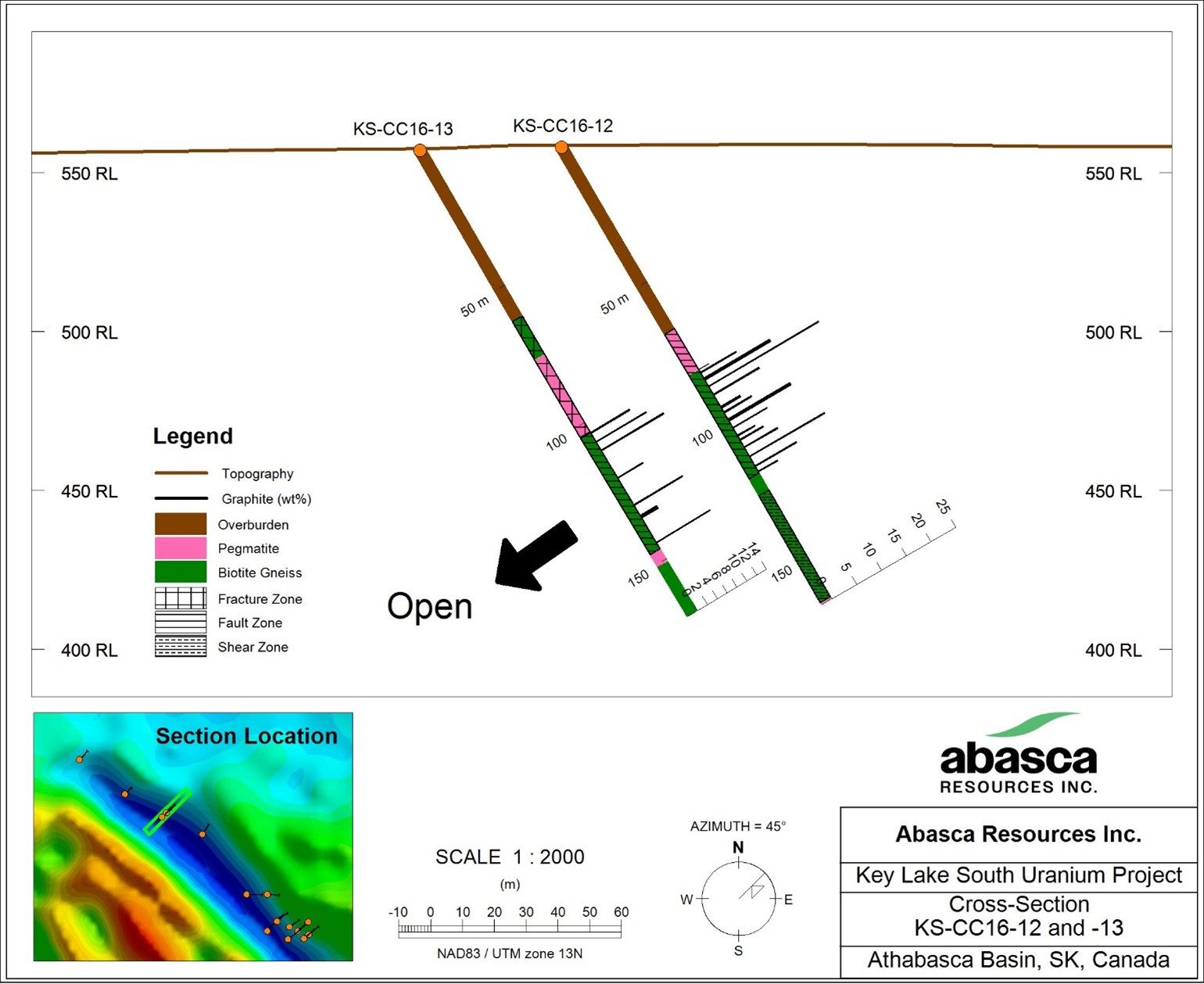
Figure 4: Cross-Section through the Campbell target area showing KS-CC16-12 and KS-CC16-13 showing the assay results of 2016 pulp samples that were re-analysed for graphite (wt%).
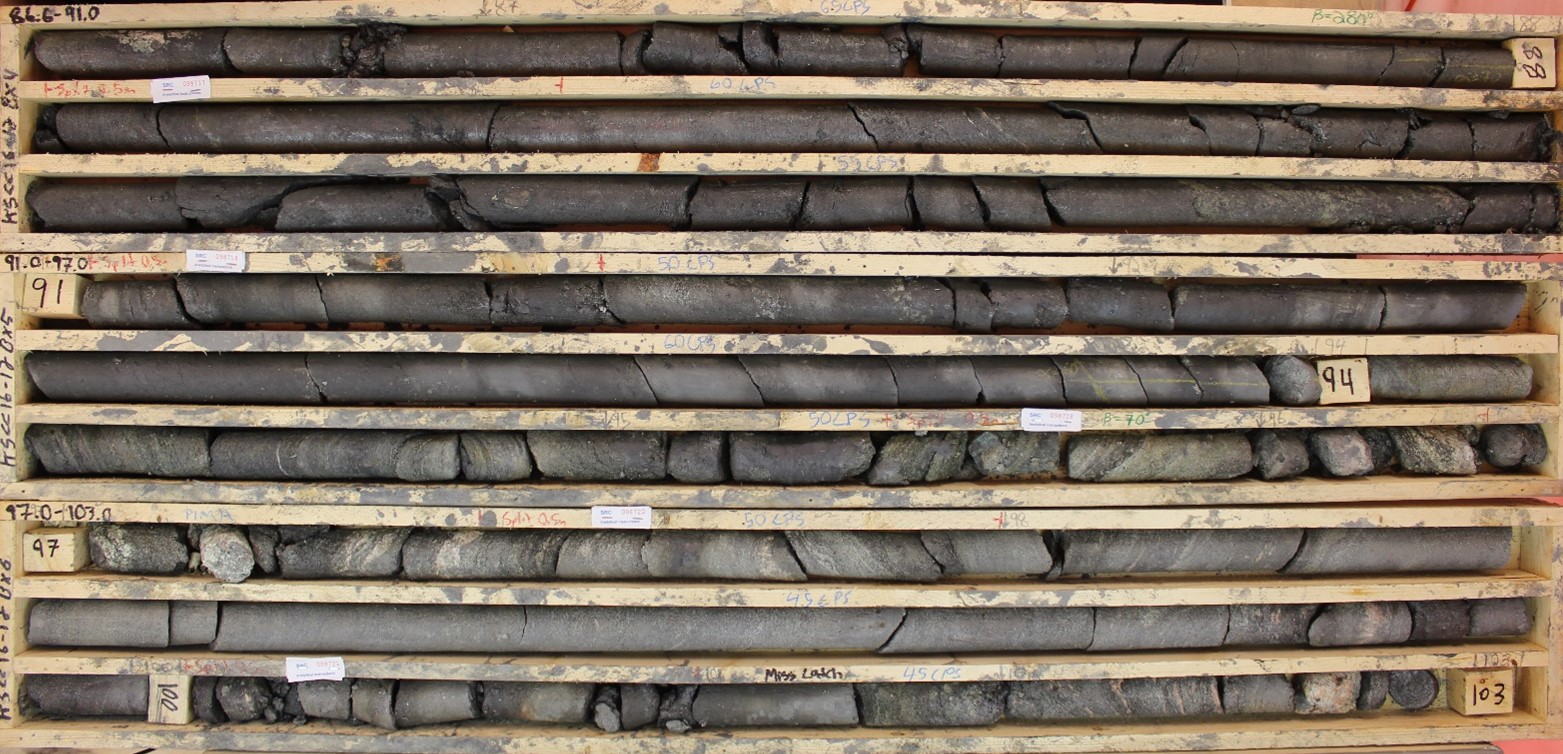
Figure 5: Core photo of drillhole KS-CC16-12 showing part of the graphitic fault intersected at the Loki Zone between 86.6 - 103.0 m in boxes 4 - 6.
Table 1: Total graphite content results from 2016 pulp samples at Loki Zone on the KLS Uranium Project. Samples were collected in 2016 as part of a uranium exploration program and only representative samples were collected within and proximal to the graphitic zone to evaluate pathfinder elements for uranium exploration and therefore the graphitic zone was not sampled everywhere it was intersected. All lengths are as measured downhole in metres and do not represent true thickness.
Drillhole ID | Azimuth | Inclination | Total Length (m) | From (m) | To (m) | Length (m) | Graphite (%) |
|---|---|---|---|---|---|---|---|
KS-CC16-01 | 90 | -60 | 181 | 51.40 | 51.90 | 0.50 | 5.61 |
KS-CC16-02 | 90 | -50 | 181 | 128.70 | 129.20 | 0.50 | 1.95 |
129.50 | 130.00 | 0.50 | 0.27 | ||||
133.80 | 134.30 | 0.50 | 9.11 | ||||
135.50 | 136.00 | 0.50 | 11.10 | ||||
136.50 | 137.00 | 0.50 | 1.97 | ||||
140.00 | 140.50 | 0.50 | 11.30 | ||||
144.40 | 144.90 | 0.50 | 2.50 | ||||
KS-CC16-04 | 50 | -60 | 169 | 54.10 | 54.60 | 0.50 | 1.62 |
63.00 | 63.50 | 0.50 | 7.19 | ||||
64.00 | 64.50 | 0.50 | 3.41 | ||||
KS-CC16-06 | 50 | -60 | 184 | 56.20 | 56.70 | 0.50 | 6.68 |
60.00 | 60.50 | 0.50 | 10.7 | ||||
64.90 | 65.40 | 0.50 | 9.64 | ||||
KS-CC16-07 | 50 | -60 | 187 | 79.50 | 80.00 | 0.50 | 1.29 |
80.00 | 80.50 | 0.50 | 0.81 | ||||
KS-CC16-09 | 50 | -60 | 172 | 40.00 | 40.50 | 0.50 | 12.30 |
40.50 | 41.50 | 1.00 | 8.99 | ||||
41.60 | 42.30 | 0.70 | 5.52 | ||||
42.30 | 43.00 | 0.70 | 13.1 | ||||
43.00 | 43.30 | 0.30 | 1.31 | ||||
KS-CC16-11 | 30 | -60 | 157 | 66.00 | 67.00 | 1.00 | 12.10 |
67.00 | 67.50 | 0.50 | 8.07 | ||||
69.50 | 70.00 | 0.50 | 7.22 | ||||
70.30 | 70.80 | 0.50 | 12.90 | ||||
72.50 | 73.00 | 0.50 | 11.00 | ||||
76.70 | 77.20 | 0.50 | 10.70 | ||||
79.00 | 79.50 | 0.50 | 16.50 | ||||
85.00 | 85.50 | 0.50 | 4.72 | ||||
89.50 | 90.00 | 0.50 | 3.91 | ||||
94.80 | 95.30 | 0.50 | 3.36 | ||||
KS-CC16-12 | 45 | -60 | 165.5 | 82.00 | 82.20 | 0.20 | 1.97 |
83.00 | 83.50 | 0.50 | 7.17 | ||||
85.00 | 86.00 | 1.00 | 13.30 | ||||
88.00 | 88.50 | 0.50 | 22.20 | ||||
91.00 | 91.50 | 0.50 | 9.20 | ||||
95.50 | 96.30 | 0.80 | 3.85 | ||||
97.50 | 98.00 | 0.50 | 5.53 | ||||
100.00 | 101.00 | 1.00 | 12.50 | ||||
103.10 | 103.60 | 0.50 | 6.87 | ||||
106.00 | 106.50 | 0.50 | 3.49 | ||||
107.50 | 108.00 | 0.50 | 4.63 | ||||
110.20 | 110.70 | 0.50 | 6.68 | ||||
113.50 | 114.00 | 0.50 | 15.10 | ||||
117.00 | 117.50 | 0.50 | 8.33 | ||||
119.00 | 119.50 | 0.50 | 3.83 | ||||
KS-CC16-13 | 45 | -60 | 169 | 103.50 | 104.00 | 0.50 | 7.83 |
106.80 | 107.30 | 0.50 | 10.10 | ||||
110.00 | 110.50 | 0.50 | 12.60 | ||||
120.00 | 120.50 | 0.50 | 5.09 | ||||
130.00 | 130.50 | 0.50 | 9.79 | ||||
134.00 | 135.10 | 1.10 | 3.32 | ||||
143.70 | 144.10 | 0.40 | 10.90 | ||||
KS-CC16-14 | 45 | -60 | 133 | 46.00 | 46.50 | 0.50 | 16.70 |
50.00 | 50.50 | 0.50 | 4.36 | ||||
55.80 | 56.00 | 0.20 | 10.50 | ||||
60.00 | 60.50 | 0.50 | 7.96 | ||||
61.00 | 61.40 | 0.40 | 4.04 | ||||
70.00 | 70.50 | 0.50 | 4.78 | ||||
78.00 | 78.50 | 0.50 | 11.80 | ||||
80.00 | 80.50 | 0.50 | 11.40 | ||||
KS-CC16-15 | 45 | -60 | 172 | 120.50 | 121.00 | 0.50 | 15.70 |
121.50 | 122.00 | 0.50 | 9.48 | ||||
124.50 | 125.00 | 0.50 | 4.84 | ||||
126.00 | 126.50 | 0.50 | 13.60 | ||||
130.00 | 130.50 | 0.50 | 1.71 | ||||
137.50 | 138.00 | 0.50 | 4.98 |
Qualified Person
The technical information in this news release has been reviewed and approved by Dave Billard, P.Geo, a Qualified Person as set out in National Instrument 43-101 - Standards of Disclosure for Mineral Projects. Mr. Billard is a director of Abasca.
About Abasca Resources Inc.
Abasca is a mineral exploration company that is primarily engaged in the acquisition and evaluation of mineral exploration properties. The Company owns the Key Lake South Uranium Project, a 23,977-hectare uranium exploration project located in the Athabasca Basin Region in northern Saskatchewan, approximately 15 km south of the former Key Lake mine and current Key Lake mill.
On behalf of Abasca Resources Inc.
Dawn Zhou, M.Sc, CPA, CGA
President, CEO and Director
For more information visit the Company's website at https://www.abasca.ca or contact:
Abasca Resources Inc.
Email: info@abasca.ca
Telephone: +1 (306) 933 4261
SOURCE: Abasca Resources Inc.
View the original press release on accesswire.com
